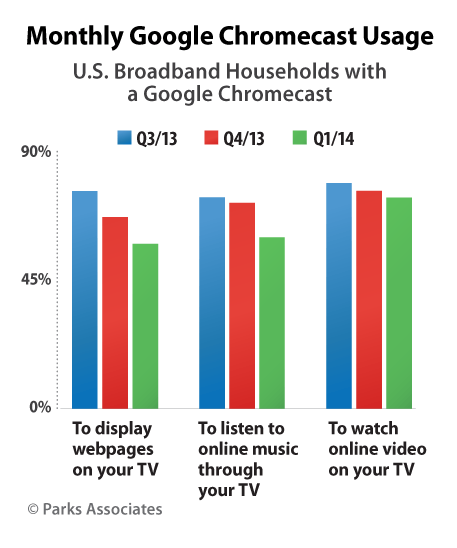Nearly 20% of U.S. Broadband households have a Streaming Media Player
Dallas, Tex., June 11, 2014--New research from Parks Associates reports that usage of Google Chromecasts appears to be decliningwhile adoption of streaming media players has increased to nearly 20% of U.S. broadband households, up from 14% in 2012.
360 View: CE Adoption and Trends, which includes data and analysis of a 1Q 2014 consumer survey of 10,000 U.S. broadband households, shows ownership of Chromecasts is steady at approximately 6% of U.S. broadband households, but monthly usage rates are slightly lower than the last two quarters of 2013. The percentage of Chromecast owners who use the device at least monthly to view web pages on a TV declined from 76% in 3Q 2013 to 57% in 1Q 2014. Similarly, the percentage of Chromecast owners who use the device at least monthly to watch online video on a TV dropped from 78% to 73%.
"Streaming media players are starting to play a bigger role in home entertainment, but interest in new entry Google Chromecast is waning," said John Barrett, director, Consumer Analytics, Parks Associates. "Streaming media players, thanks to their ease-of-use, trail only game consoles and smart TVs as the most frequently used streaming media device in the home. By contrast, only about 22% of Chromecast owners say it is the most frequently used streaming device in their home.”
The research also finds smart-TV adoption increased to over one-third of U.S. broadband households.

"As consumers add new devices to their home, the usage habits in the home change and adapt to the new device, its benefits, and its capabilities," said Brett Sappington, director, research, Parks Associates. "Chromecast was introduced last summer. Given the low price, many consumers purchased one and began experimenting with it, producing high initial use. Over time, however, owners developed a better understanding of Chromecast’s usefulness and appropriate niche in the video-viewing environment. Some continue to use Chromecast regularly, while others are choosing different options to get online video to their televisions.”





